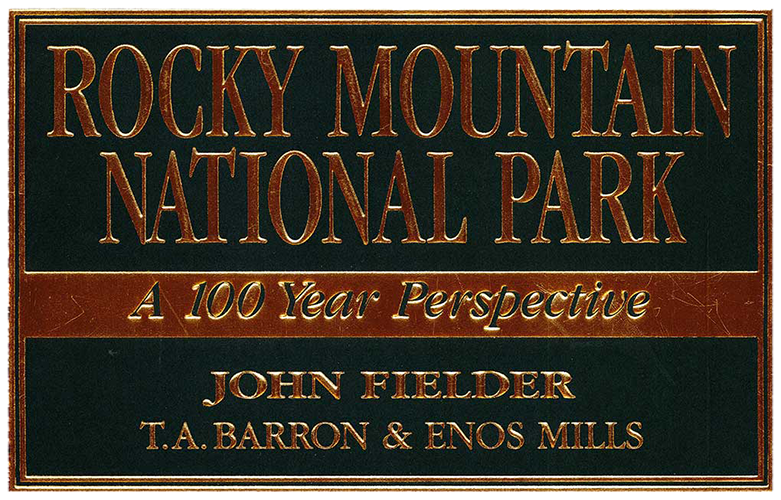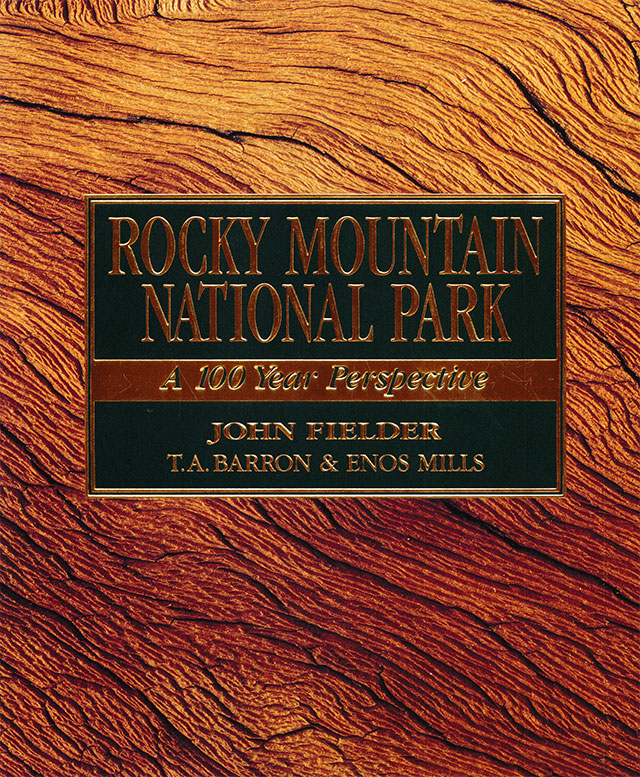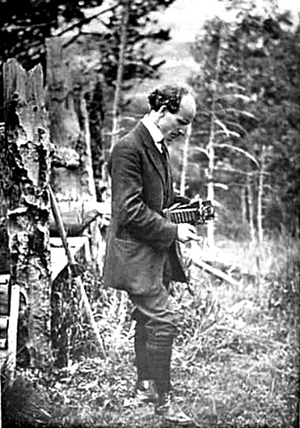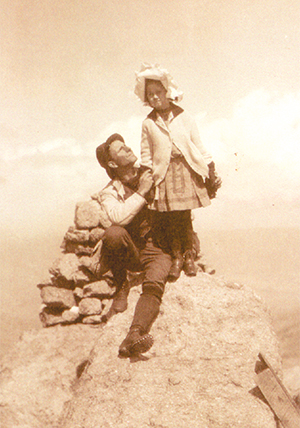
ROCKY MOUNTAIN NATIONAL PARK EXCERPT

The Gift of Enos Mills
By T. A. Barron
When Enos Mills returned to his homestead cabin one day in the late nineteenth century, he sat on his porch and gazed across the valley at the towering ridges of Mount Meeker and Longs Peak. An idea as grand as the scenery suddenly possessed him: to protect this place, forever, as a national park.
National park. The very words were revolutionary. The concept of a national park, both distinctly American and distinctly new, had only recently become a reality at a place called Yellowstone. Enos Mills knew that powerful forces — whether powered by ignorance, apathy, or greed — would oppose him. Yet he determined to set out on his quest to protect this place he called a “marvelous grouping of gentleness and grandeur,” this place where “the world stays young.”
No matter whether he would succeed or fail, he knew he must try. And he also knew that the beneficiaries of his success would be more than the land itself and all its inhabitants. As much as he loved them—the ancient bristlecone pine, the bull elk, the sparkling cascade, the water ouzel, the cunning coyote, the glorious summits — they were not his only concern. The mind, body, and soul of humanity were much on his mind. As he wrote in his essay “National Parks and National Life,” our very salvation may well depend on our ability to keep a few places truly wild.
Just as Enos Mills’ writing is filled with his passion for the land, he knew that many others would share that experience if only the land could be protected for future generations. His granddaughter, Elizabeth Mills, told me that he would often greet his travel-weary guests with an exuberant question on their first morning: “Aren’t you glad to be alive?”
A few days after I spoke with Elizabeth, I was hiking on the trail to Cub Lake with my wife and our three small children. Needles of ice glistened in the stream, while the morning sun warmed our necks. The air vibrated with the fragrant scents of emerging spring. A great blue heron chortled on high, then an elk bugled from across the meadow. Birds chattered, water bubbled, pikas whistled. Then, without warning, we felt the ground shake beneath our feet as a dozen elk poured across the trail. Watching them depart, my five year-old son, Brooks, turned to me and asked, “Daddy, aren’t you glad to be alive?”
Enos would have been pleased.
So one hundred years ago, this energetic and visionary man started writing, speaking, and crisscrossing the country to explain the wonders of this remarkable place to anyone who would listen. Fortunately, those in power ultimately heard his pleading, and Rocky Mountain National Park was finally created by an act of Congress in 1915. An editorial in The Denver Post expressed the appreciation of those who had witnessed his efforts:
 “It was Enos A. Mills, who conceived the idea of conserving nature’s wonderful workmanship in the Longs Peak region by placing it in the keeping of the United States Government, and, single-handed, he set out to accomplish this result. Single-handed, he brought it about, for all the forces that have contributed to the victory were lined up through his efforts. Others have helped, to be sure, but it was by Enos Mills’ persistent labor that they were made supporters of the movement…So let Colorado take off its hat to Enos Mills.”
“It was Enos A. Mills, who conceived the idea of conserving nature’s wonderful workmanship in the Longs Peak region by placing it in the keeping of the United States Government, and, single-handed, he set out to accomplish this result. Single-handed, he brought it about, for all the forces that have contributed to the victory were lined up through his efforts. Others have helped, to be sure, but it was by Enos Mills’ persistent labor that they were made supporters of the movement…So let Colorado take off its hat to Enos Mills.”
When the park was established, the region was still primarily wilderness, home to the mountain lion and the grizzly bear, much of it untrammeled by people but for the occasional Ute or trapper hardy enough to have roamed its ridges. Yet Enos Mills knew that time was fast running out. More and more settlers were streaming westward. Local elk had already been hunted almost to extinction. To get the point across, he would sometimes tell a story about Henry Clay, who once stopped a speech to affect the pose of a man listening to some approaching sound. When asked what he was hearing, Clay replied, “the footsteps of the coming millions.”
Nearly a century later, Rocky Mountain National Park exists in close proximity to four million people, little more than an hour’s drive from metropolitan Denver. Last year, more than three million people visited the park, about the same number who visited Yellowstone, a park eight times the size. The elk population has rebounded to a number that creates management problems outside the park and devastation of willow and aspen groves inside. The towns of Estes Park and Grand Lake, hugging tight to the park’s boundaries, continue to expand.
As John Fielder and I discovered, much true wilderness still exists here. Some areas, especially above tree line, are largely undisturbed, almost as pristine today as they were in the time of Enos Mills. Yet the balance is precarious, and the pressures on the park continue to mount.
Today’s park administrators, employees, and volunteers are struggling to protect it from the escalating crush of people and pollution. Park Superintendent Homer Rouse started as a seasonal ranger on Trail Ridge almost thirty-five years ago, then “worked my way down from there,” as he puts it, to the responsibilities he holds today. During that time, the park as well as the surrounding world has changed dramatically. Some national parks, like Everglades, Yosemite, and Grand Canyon, are at serious risk of being choked to death by the high-season traffic, or by air and water pollution. Will Rocky Mountain National Park be able to avoid the same fate? Will it be able, by example, to offer solutions to other great parks?
The National Park Service has a dual, sometimes contradictory, mandate. On one hand, its purpose is to protect and preserve many of our grandest, wildest, most inspiring places — the crown jewels of the American landscape. On the other hand, its purpose is to promote people’s enjoyment of the national parks. To reconcile the two, the management of Rocky Mountain National Park — and every other major national park — must make difficult decisions on matters as diverse as mass transportation, fire control, water rights, air and water pollution, wildlife migration routes, back-country camping, and community relations.
Undoubtedly, solutions will require bold, creative thinking, as well as hard work. It will also require treating “ecosystem management” as more than just a catchy phrase. It is a necessity. For our national parks and wilderness areas to survive intact into the twenty-second century and beyond, we must understand and respect the complex relationships between urban and rural settlements, alpine and lower altitude zones, public and private lands, animal migration corridors, water and air flows, species diversity, and prevailing weather systems. The answers lie in knowing the whole as well as the parts.
In the midst of this web of difficult issues, can we find any help from the vivid writings and sensitive photographs of Enos Mills? I believe the answer is a resounding yes. For starters, Enos Mills was not restricted by artificial boundaries in what he saw. The entire ecosystem, in all its complexity, lay before him. That grander perspective is essential to managing our national treasures in these challenging times.
Secondly, he succeeded in his efforts largely because he never forgot to let the land speak for itself. He showed fundamental respect, and basic humility, toward all that was there before humans arrived. His own personal experiences served to illuminate, not crowd out, the spirit of the place. His daughter, Enda Mills Kiley, who lives not far from Enos’ original homestead cabin and gladly shows it to people during the summer months, told me: “When he took people outdoors, he featured nature instead of featuring how much he himself knew. His whole goal was to get people curious, to help them observe.” She added with a grin, “He was especially concerned for underprivileged folks from places like New York and Boston.”
 He had great patience with visitors, whether an inquisitive eight-year-old girl or middle-aged business tycoon. His files contain correspondence with some of the leading figures of his day: Theodore Roosevelt, John Muir, John Burroughs, Kit Carson, John D. Rockefeller, Eugene Debs, Booker T. Washington, Gifford Pinchot, Lowell Thomas, and Helen Keller (who reminded him, “Nature never did betray the heart that trusted her.”) Yet his favorite correspondent may well have been a young girl from Arkansas named Harriet Peters. In September 1905, shortly after her eighth birthday, he guided her to the summit of Longs Peak. Her first question, as Enos recalled in his essay “Harriet—Little Mountain Climber,” was “What lives at the top?” (Her second question was “Is it uphill all the way?”). Enos summed up their experience this way: “Of the two hundred and fifty-odd trips which I made as a guide to the summit of this great old peak, the trip with Harriet is the one I like best to recall.”
He had great patience with visitors, whether an inquisitive eight-year-old girl or middle-aged business tycoon. His files contain correspondence with some of the leading figures of his day: Theodore Roosevelt, John Muir, John Burroughs, Kit Carson, John D. Rockefeller, Eugene Debs, Booker T. Washington, Gifford Pinchot, Lowell Thomas, and Helen Keller (who reminded him, “Nature never did betray the heart that trusted her.”) Yet his favorite correspondent may well have been a young girl from Arkansas named Harriet Peters. In September 1905, shortly after her eighth birthday, he guided her to the summit of Longs Peak. Her first question, as Enos recalled in his essay “Harriet—Little Mountain Climber,” was “What lives at the top?” (Her second question was “Is it uphill all the way?”). Enos summed up their experience this way: “Of the two hundred and fifty-odd trips which I made as a guide to the summit of this great old peak, the trip with Harriet is the one I like best to recall.”
On rare occasions, Enos’ patience could wear out. Once, when he arrived in New York to speak to a prestigious club, he was informed that he would need to wear a more formal suit. He responded by sending to the club a cleanly pressed suit and a note that read, “If you want a suit, here it is. If you want a speaker, come find me in Colorado.”
Enos Mills left behind a wealth of written and photographic material. His essays are collected in books with titles like The Spell of the Rockies, Wild Life on the Rockies, Rocky Mountain National Park, and Adventures of a Nature Guide. From these sources and others — including his unpublished journals — we have selected, condensed, and titled some of his very best work for this book.
While his writings brim with reverence and enthusiasm for wild country, they also venture beyond those themes. His powers of observation were often impressive, his vision sometimes prophetic. His unpublished journals contain passages discussing the limits of a purely utilitarian view of the land, the values of beauty and silence and clear skies. He once wrote, far ahead of his time, about the “interdependence of yuccas and the moths which fertilize them,” predicting that “to exterminate one would cause the other to die.” In his later years, he wrote philosophically about war and peace: “It may be that if we quit shooting animals on one side of a park boundary line, we shall in due time become sufficiently civilized to stop killing people on the other side of a national boundary line.”
Great dignity and genuine poetry resided in this man. He said at the funeral of a neighbor, Mrs. R. H. Tallant, that “she was unobtrusive and as definite as the spruces on the height by her home.” The silver spruce itself he called “an evergreen poem of the wild.”
The Park Service granted a special research permit to make our project possible, seeing John’s photographs as a means of documenting a visual scientific record of the park’s wildest regions. While John’s images illuminate the grandeur, diversity, and ever-changing drama of the park, my own written passages are meant to bring to life some of its many moods, wonders, and surprises.
The organization of this book is intended to give readers a chance to compare the landscape of one hundred years ago, in black and white, with the landscape of today, in color. The first section features some of the finest photographs and passages composed by Enos Mills at the dawn of the twentieth century. In the second section, John and I, with a little help from Enos, try to convey the spirit of Rocky Mountain National Park at the dawn of the twenty-first. The last section contains John’s personal journal recorded with pen and camera, detailing eight eventful weeks exploring and photographing the park.
Creating this book offered us an extraordinary opportunity to experience the glories and subtleties of Rocky Mountain National Park. As we did so, our thoughts often turned to the man whose efforts opened the door for ourselves and so many others. The true gift of Enos Mills was not so much a park as it was a chance — the chance to experience this land for ourselves, to convey it intact to future generations, to cherish forever a place where “the world stays young.”
